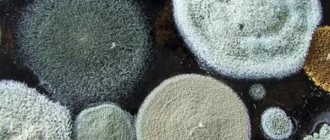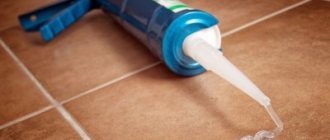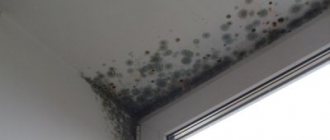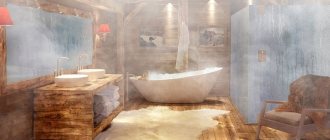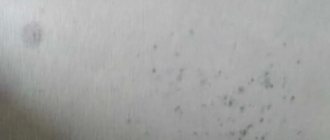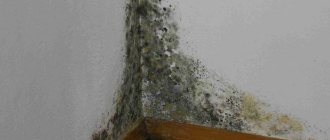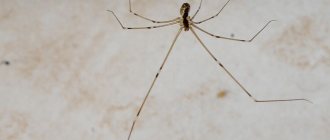Existing methods of getting rid of fungus and mold
If, despite taking preventive measures that were not taken in a timely manner and therefore did not give the desired result, mold appears in the bathroom, get rid of it immediately. Delay in this case threatens the spread of fungal colonies throughout the room - they will move from the walls to the ceiling, and begin to affect the floors, mirrors, and furniture.
We use folk remedies to remove fungus from the surface in the bathroom.
There are many “grandmother’s” ways to combat harmful fungi - this is treating the contaminated surface with products that can be found in any housewife. You can also clean surfaces using technologies that use special aggressive antiseptic solutions.
Necessary safety measures when working to destroy fungus
Many mold removal products are toxic and poisonous, so when working with them you should follow safety precautions:
- wear gloves to protect your skin;
- wear a respirator to protect the respiratory system;
- Protect your eyes with goggles from getting dangerous liquids into them.
Protective equipment - goggles, waterproof gloves, a respirator - are required when working to remove mold.
If such liquids come into contact with the skin or eyes, the affected area should be rinsed with plenty of water and consult a doctor immediately. Even when using safe products, it is advisable to protect the respiratory system at the moment when active cleaning of tile joints with a brush is carried out, since mold spores can easily enter the body at this moment. It is also worth protecting the surfaces in the room so that mold spores do not enter and take root on them. To do this, everything that can be taken out of the bathroom should be taken out, and the rest should be covered with something dense - for example, polyethylene or a special film used in construction. Once cleaning is complete, this material should be discarded.
If the bathroom has forced ventilation in the form of a fan, it must be turned off during cleaning, since mold spores are easily picked up and carried by air movement.
All items used during cleaning - brushes, sponges, respirators, gloves - upon completion of work must be immediately placed in tight bags that exclude the possibility of ventilation and thrown away.
General recommendations
It is necessary to disinfect shoes against fungus, even if a person does not suffer from nail fungus.
It is worth disinfecting your feet, shoes and socks regularly, especially when visiting baths, saunas and swimming pools. Antifungal drugs are bought at the pharmacy or used folk remedies. Antifungal treatment of shoes for toenail fungus involves creating an unfavorable environment for a long time for the fungus located in the fabric of the inside of the shoe. To destroy mushrooms, you need to create an acidic environment. This is achieved by soaking shoes with vinegar or its vapor for 24 hours. To effectively disinfect each area and type of surface, different means are used. Everything that the patient regularly touches needs to be disinfected:
All things that have come into contact with nails infected with fungus must be disinfected.
Exotic ways
In some cases, mold can be dealt with by applying baking soda to the mold-affected seams. But in this case, the abrasive properties of the substance are used rather; soda is not able to fight deep lesions. Some homeowners have tried eliminating mildew and mold using expensive products like tea tree oil and grapefruit seed extract. But, firstly, tea tree oil has a strong specific aroma that does not disappear for a long time, and secondly, these drugs are more suitable for prevention than for active control, when blackness is visible from everywhere. In such cases, mold can only be removed with the help of specialists.
How to use antiseptics against mold
When purchasing professional anti-fungal compounds, make sure that they are designed to eliminate mold and not to prevent its occurrence.
Read the label carefully or consult your retailer. Follow the manufacturer's instructions for the product. Among the special antifungal agents are the following:
- “Milkill” does not pose a risk to human health and allows you to treat surfaces with a very fine porous structure.
- “Antifungal” is an excellent remedy against fungus and mold, allowing you to remove fungus from walls of any structure and origin.
- “Hydrotex”, “Izotsid” - created specifically for antifungal treatment of rooms under constant exposure to high humidity.
Causes
Black mold, which is not so easy to get rid of, appears in the bathroom for a number of reasons. These are high humidity, improperly processed materials or poor ventilation. Before choosing a method to remove mold in the bathroom between the tiles on the floor or wall, it is worth learning more about the reasons for its appearance. Eliminating them will reduce the likelihood of fungal growth.
Humidity
The main reason why it is difficult to get rid of black mold is the constant humidity in the bathroom. The fungus loves dampness, and it is impossible to get rid of it in the bathroom for very obvious reasons. Splashes of water and steam condensation constantly settle on surfaces, promoting the growth of mycelium.
Darkness
Electric lighting is not enough for the bathroom; mold spores thrive under it. The presence of a window through which sunlight penetrates could improve the situation a little; it would be easier to remove the fungus in the bathroom - it dies under the influence of ultraviolet radiation.
Poor ventilation
Getting rid of fungus in the bathroom will be difficult if there is no free air circulation. In a confined space, moist air will not be able to escape, thereby the moisture concentration will increase, which is favorable conditions for the development of mold spores.
Lack of antiseptics
Some wall and floor coverings are treated with antiseptics at the production stage, but do not think that this is enough. Seams or joints, as a rule, remain unprotected, water can penetrate there, and black mold will gradually develop there.
Why does mold appear on sealant?
High humidity leads to the formation and development of mold spores. Here are the factors contributing to the problem:
low quality sealant leads to damage to the integrity of the joints;
the seams are not made in good faith, as a result, cracks and crevices appear in them;
ventilation does not remove excess moisture, heating maintains the temperature above the standard level;
dampness increases due to broken plumbing and leaking water pipes.
IMPORTANT. Before taking action, it is necessary to find out the reason for the appearance of the fungal colony. This will help you choose the most effective way to fight.
Where does the fungus come from?
Fungal spores are present to a small extent in almost all rooms, as they move through the air with great ease. But their further development occurs only in a certain environment.
Important! If you do not promptly pay attention to small black or greenish spots in the corners or between the tiles, the lesions will begin to grow in all directions. The bathroom is an ideal environment for fungus to spread. It’s warm there and, most importantly, regularly high humidity
The fungus successfully settles and multiplies on any surface, be it wood, plastic, tile
It is warm there and, most importantly, there is regularly high humidity. The fungus successfully settles and multiplies on any surface, be it wood, plastic, tile
The bathroom is an ideal environment for fungus to spread. It is warm there and, most importantly, there is regularly high humidity. The fungus successfully settles and multiplies on any surface, be it wood, plastic, tile.
Fungus under a microscope
The main causes of fungus and black mold in the bathroom
Before you start fighting black and gray plaque on the ceiling and walls, you need to identify the main reason for its appearance.
The main factors for the occurrence of fungus in the bathroom:
- High humidity due to leaky taps;
- Wet towels;
- Lack of ventilation or low intensity;
- Lack of natural light;
- Cast iron pipes and cold walls, on which condensation often forms;
- Weak heating of the heated towel rail;
- Water constantly drawn into the bathtub and other open containers.
The presence of several items from the list of factors is quite enough for the manifestation of mold or mildew. To prevent such troubles, you can act like this:
- Install an additional hood or mount a fan on the main hood;
Healthy! You can install a fan using a special technology so that it starts working after turning on the light in the bathroom and, accordingly, turns off when the light is turned off. - Instead of cast iron pipes, install plastic ones;
- Insulate the walls of the room;
- You can buy a heater or a powerful towel dryer.
Removing fungus in the bathroom using household chemicals
The modern chemical industry produces a huge amount of fungicide substances that can quickly cope with even serious outbreaks of fungus in the bathroom. The principle of use for most of them is the same - an antifungal agent or its solution is applied to a wall, ceiling or plumbing affected by mold with a spray bottle, then a certain time is waited, and then the same area is washed with water.
Chemical antifungals
Below is a list of the most popular and effective household chemicals designed to combat such microorganisms:
- DALI;
- MILLKILL
- Atlas Mykos;
- SZAVO;
- "Spectrum Fungicide";
- "Titan Fungicide";
- Belinka;
- Mellerud;
- Astonish.
Izocio
Mellerud product
Important! Before using any household chemicals to remove fungus in the bathroom, carefully read the instructions for use. It is advisable to do this in the store, when choosing a product.
Another remedy against mold in the bathroom, a very unusual one, is an ionizer. When activated, it emits smoke containing silver ions. Quite quickly, this smoke fills the entire bathroom, penetrating into the most inaccessible places, disinfecting them and killing fungus. Use the ionizer block as follows.
Step 1. Open the package and take out the checker.
Ionizer for the bathroom
Step 2. If ventilation in the bathroom is forced, using a fan, turn it off.
Step 3. Pour some water into the checker box and place it on the floor in the center of the bathroom.
Step 4. As soon as heavy smoke starts coming out of the bomb, exit the bathroom and close the door. If necessary, tuck the door from below with a rag.
There is a lot of smoke coming out of the bomb
Step 5: Wait approximately 90 minutes.
Step 6. Ventilate the room and inspect the bathroom. Remove any remaining mold with a rag or brush.
Prices for fungus removers
fungus remover
Processing socks
Treating socks for nail fungus involves boiling them in a special solution or treating them with a pharmaceutical antifungal agent. Boil socks in a solution prepared from available materials - soap and soda. They are mixed in the amount of 100 grams of baking soda, 50 grams of laundry soap and 5 liters of water. The pharmaceutical product “Formidron” kills all types of fungal infections on fabric, the same thing happens if you use the “Alaminol” washing solution. During treatment, it is recommended to change stockings more often so that the fibers of the fabric do not have time to multiply new microorganisms and re-infect them.
How to remove mold and protect yourself from its occurrence
If fungus appears, you need to know exactly how to deal with mold on the ceiling in the bathroom. But first, let's figure out how to protect ourselves from the appearance of colonies in the future.
To do this, adhere to the following rules:
- Ensure proper operation of the ventilation system. If necessary, clean the ducts and air ducts in a timely manner.
- Do not allow the ceiling to get wet for a long time. Repair pipelines, repair the roof and solve the problem with neighbors who constantly drown you.
- If you decide to install a film stretch ceiling, provide ventilation grilles in it in advance.
- If the bathroom has window openings, which is often the case in a private house, then ensure that sunlight enters the room. Ultraviolet light kills fungal microorganisms.
- When installing a ceiling in a private house, use all the necessary layers - insulation, vapor and waterproofing.
- Dehumidifiers can be used to reduce indoor humidity levels.
- To dry clothes, select a balcony or loggia, or dry it outside.
- After washing in the bathroom, turn on forced ventilation for 15 minutes or leave the door open.
Mold removal
Now let's figure out how to remove mold from the ceiling in the bathroom. The appearance of fungal colonies can be guessed by the characteristic unpleasant odor in the room and stains on the walls and ceiling.
To get rid of fungus, prepare the following:
- stepladder;
- rollers and wide brushes;
- antifungal impregnation;
- tray for liquid solutions;
- spray;
- protective gloves for hands;
- putty knife;
- respirator;
- polyethylene film.
We carry out the work in the following order:
- Cover the floor and plumbing fixtures in the bathroom with plastic wrap.
- Wet the ceiling with water by spraying it from a spray bottle. After the finishing layer is well soaked, remove it to the base using a spatula. This must be done for the reason that mushrooms grow into the structure of the plaster or finishing material.
- When cleaning affected surfaces, grab 150mm of clean finish on each side. This is explained by the fact that fungal spores do not immediately germinate on the surface, but may be present in the structure of the material.
- Next, thoroughly wash the concrete ceiling and let it dry.
- We carry out antiseptic treatment. Apply the antifungal agent to the ceiling using a brush or roller. After applying the first layer, let it dry for a couple of hours, then repeat the treatment. If desired, you can apply the primer in three layers.
- After the impregnation has dried, we restore the finishing ceiling covering in this area.
Mechanical method of removing fungus
One of the tools you will need to remove fungus mechanically is a spatula.
When black spots appear on the sealant in the joints between tiles in the bathroom or on the walls in living areas, the affected coating must first be removed. Different tools are used for this:
- putty knife;
- steel brush;
- grinding attachment (installed on the drill);
- sharp knife, etc.
To prevent the spread of spores through the air (the main method of contamination of surfaces), the cladding must be treated with water. To do this, it is recommended to use a spray bottle. If you use a sponge or rag, some of the spores will become airborne when the material comes into contact with the surface. When the fungus has already penetrated the structure of wood or concrete, the milling method is used. When the infection is severe, mold is also found on inorganic surfaces. If you plan to fight it yourself, it is important to follow the instructions:
- The surface is moistened with water from a spray bottle.
- They free load-bearing structures from cladding: wallpaper on the walls, whitewash on the ceiling, flooring. This will allow you to get to the mycelium.
- If it turns out that the mold has penetrated deeper into the structure of the material of the supporting structure, remove the layer of plaster. It is necessary to clean the wall down to the rough base - brickwork, concrete.
At the next stage, chemicals are used. However, if the preparatory work (mechanical cleaning) did not provide the required result, special means will not destroy the fungus. It will continue to develop on the adjacent site.
Chemical agents can also be used against fungus.
Folk recipes
There are quite a lot of remedies for mold and mildew in the bathroom, which can easily be prepared from what is in the kitchen cabinet. They can easily cope with the problem when the mycelium is not yet too large. Let's consider the most popular means.
Vinegar
An excellent remedy for black mold in the bathroom, acetic acid is found in every housewife. Acetic acid can be used on its own or as part of a more complex anti-fungal treatment.
The easiest way to clean grout or slabs is to apply acetic acid to all areas affected by mold. Wait 10 minutes, then scrub the seams well with a sponge and rinse the surface with warm water.
Baking soda
You can treat the bathtub against fungus using regular soda. It is enough to mix the soda slurry in a small bowl and apply it to the seams with a regular brush. Clean the joints thoroughly and rinse off any remaining soda with water. Don't forget to wipe the tiles dry.
Using soda you can remove not only mold, it perfectly cleans any dirt. However, you should understand that cleaning with baking soda will only last for a short time.
Tea tree essential oil
You can remove mold from bathroom grout using tea tree oil. It is enough to dilute it (2 teaspoons) in warm water (2 tbsp.) and apply the resulting liquid to the tiles using a spray bottle. Leave the oil solution on the tiles; there is no need to wash it off. To prevent the smell from disturbing household members, cleaning can be done at night or when no one is home.
Acidic solution
You can kill fungus in the bathroom using a solution of boric and acetic acid with hydrogen peroxide and water in proportions 1: 2: 2: 4, respectively. Wipe the affected areas well with the prepared solution.
Anthracene oil
Unlike previous products that can be used to clean off mold in the bathroom on tile seams, anthracene oil is used only to prevent the occurrence of fungus. When using this product, keep in mind that the oil has a pronounced unpleasant odor; the room must be ventilated.
Borax
At home, you can get rid of fungus in the bathroom using borax, mixing 1 glass per 2.5 liters of water. The mixture is applied to the affected areas after cleaning with other means; there is no need to rinse off the solution, but the surface should not be left wet. To remove excess moisture, wipe the tiles with a dry cloth or paper towels.
Camphor
It will only help at the initial stage of mold infection. To combat a dangerous fungus, simply place a few balls in the corners and places most susceptible to infection.
Iodine
Iodine vapor is also a good remedy that will help fight fungus in the bathroom. It is enough to add 10 mg of iodine to a glass of water, and simply leave the resulting solution on the shelf.
Household chemicals
If traditional methods do not help, it’s time to move on to household chemicals. You can buy special products at a hardware or construction store.
Oxygen bleach.
Bleach is based on sodium percarbonate, it copes with different types of mold: brown, yellow, black. With its help, you can remove fungus from curtains in the bathroom and tile joints. Dissolve 12 teaspoons of bleach in a liter of warm water, wet the surface with the solution and leave for an hour. Then clean the surface with a brush and wash away any remaining mold.
White.
Whiteness will help in the fight against black mold, one of the most toxic types. Apply the solution to the surface and leave for 10-15 minutes, rinse with water. Please note that the product cannot be left on painted surfaces for more than five minutes, otherwise the picture will fade.
Prevention
Getting rid of fungus on bathroom walls is very difficult; it is often a long process, and mold is tenacious. It is much easier to take measures against its appearance, this will reduce the risk of mold development, and if it does appear, prevention will help to quickly cope with the problem. Here are some useful tips to help prevent black fungus from appearing on tiles and other surfaces:
- Since humidity is perhaps the primary cause of mold, its level must be carefully monitored. It should not exceed 30%.
- The bathroom needs to be well ventilated, so make sure you have a quality fan.
- After showering, always open the door for a while.
- If you plan to make repairs, be sure to treat all surfaces with an antiseptic before finishing.
- Monitor the condition of pipes and plumbing; there should be no leaks, and all minor accidents must be repaired immediately.
- Perspiration often appears on metal pipes, so they should be replaced with polypropylene.
- Be sure to treat all joints and seams with sealant, especially the gaps between the bathroom and the walls.
- After washing, you should not dry clothes and linens in the bathroom.
- Hanging shelves, soap dishes and cups for brushes must always be dry, otherwise they may also develop fungus.
- You should not choose furniture made of wood; this material is vulnerable to fungus and quickly deteriorates.
Following simple rules for preventing the appearance of black mold at home will help avoid this scourge. If the fungus does appear, you need to get rid of it as quickly as possible.
So, the more advanced the case, the more difficult it is to get rid of black mold. To avoid having to do a major overhaul of the entire bathroom, it is better to immediately prevent the development of fungus by regularly cleaning and monitoring the humidity level. Good sealants, dryness and constant air circulation guarantee the absence of mold.
Preventing mold in the bathroom
Prevention prevents the reappearance of fungus indoors. Important:
- Find out the correct location of the ventilation ducts. If necessary, call a specialist. He will conduct a professional inspection and report on the operation of the ventilation.
- After using the shower or bath, wipe the walls with a towel, removing excess moisture. Leave the door open.
- Be sure to use the kitchen hood when cooking or boiling water.
- Avoid growing indoor plants: geraniums, violets. They cause mold.
- When repairing walls, use a primer treatment. It prevents the appearance and spread of fungus.
- Insulate the walls in the apartment. Especially on the north side. You can use special impregnation during work.
- If cracks appear in the walls, they must be sealed. Carefully check the baseboards for drafts. Frequent temperature changes in the apartment are not allowed.
- Buy devices that absorb moisture. Place on all windowsills.
When fungus appears on the walls, tiles, bathrooms, or under the sink, it is important to do some work.
There are many types of mold, but if you eliminate it in time, there will be no consequences. Fungus is removed using chemical and folk remedies.
No antifungal grout will help if there are suitable conditions for the formation of fungus and mold
In advanced cases, the affected areas are often replaced. Chemicals will not help if the fungus is deeply embedded. Prevention is necessary. Then the mold will not affect the apartment premises.
Popular folk remedies against fungus
Since professional products to help fight fungus were not previously available in stores (they appeared relatively recently), our ancestors in the old days used solutions that were poisonous to mold. Of course, among them there are also dangerous ones for people, using which it is necessary to take protective measures. A man must:
- Wear special clothing;
- Hands should be protected by gloves;
- A respirator is suitable for respiratory protection.
In addition, when treating premises, children and animals should not be in the apartment. Before starting to treat the room, assess the size of the problem:
Black or brown spots in small quantities should not cause you much concern - they can be destroyed using a construction knife and a swab, which is moistened in a special detergent for plumbing.
To remove large lesions that have grown to sizes greater than 10 cm, a serious approach is required.
If the mold is already huge, spreading rapidly deep into the walls, and even penetrates into other rooms of the apartment, urgently call a professional team.
Creosote is a powerful and aggressive anti-fungal agent made from tar. Since ancient times, it has been used in the railway industry - it is used to treat sleepers and wooden building structures, protecting them from rot.
Creosote is a pungent, strong-smelling, oily liquid with a slight yellowish tint. It is difficult to dissolve in water, so it is diluted with ethers or alcohol. The product is very dangerous to health, therefore, after using it to remove mold, then rinse it well from the surfaces.
It is prohibited to treat wood paneling and furniture with creosote, since this strong agent can be absorbed into the loose structure of the wood, after which it cannot be removed.
Creosote can be used to treat concrete, ceramic tiles and bricks. After this, it is necessary to thoroughly wash the treated areas with detergents, and then rinse them with plenty of running water.
Removing sealant from mold
Intrusive mold even lives on sealant. Therefore, it is advisable to use a sealing agent with the addition of fungicidal components against fungus. We will learn how to remove mold in the bathroom using silicone sealant and clean the seams with your own hands.
- Cut off the sealant with a knife. Make cuts in the sealant and, picking up the silicone mass, pull it out of the tile joint. Remove mold by thoroughly cleaning the seams.
- Eliminate mold on caulk with cleaner and bleach. Dilute bath cleaner in a container of water and stir. Use a sponge soaked in the solution to clean the mold-affected areas. Thoroughly rinse off any remaining mold and cleaning agent. Take bleach and spread it over the sealant. After twenty minutes, scrub the surface with a brush. Rinse with clean water and dry the sealant with a dry cloth.
- To prevent the fungus from appearing again, use isopropyl alcohol. Pour alcohol between the tiles and wait half an hour. Blot the remaining alcohol with a cloth and leave overnight. After the seams have dried, you need to re-treat the cleaned areas using new sealant. You can use the bathroom no earlier than every other day.
How to normalize humidity levels
Before removing mold, you need to create an unfavorable environment for its development. First you need to check if there are any undetected water leaks in the bathroom. This could be a drain hose from a washing machine, a hole in a pipe, or a leaky joint between a bathtub or shower stall and a wall. A never-drying puddle of water is a surefire way to maintain a high level of humidity in a room. The source of fungus is often the shower tray or the floor under the bathtub.
The second step to normalizing humidity levels is good ventilation. The ventilation duct is responsible for this. In old multi-storey buildings, ventilation is often poor. In this case, it is necessary to equip the restroom with an additional ventilation unit or purchase a dehumidifier. Don't keep the bathroom door closed. This is a bad habit that contributes to the accumulation of moisture in the room. Do not dry towels in the bathroom; take them to the balcony or another room with better ventilation.
Why is mold dangerous?
Mold produces toxins that are harmful to people. They affect liver cells, suppress the immune system, but most of all harm the respiratory system: they clog the pores of the lungs and cause allergies. This fungus can cause the development of serious diseases: asthma, pneumonia, dermatosis.
Mold also harms building materials: it destroys plastic, enamel, and wood. The fungus multiplies quickly: if it appears in the bathroom, it can easily spread to other rooms.
What is a fungus and its types
A fungus is a microorganism whose spores are present in small quantities in all interior spaces, but certain conditions are required for their growth. The ideal environment for the proliferation of microspores is warmth, high humidity, and lack of sunlight. It is these conditions that are created in the enclosed space of the bathroom and are the main reasons for the concentration of fungal spores.
Black fungus can live and reproduce on any surface
Three types of fungus are found indoors:
- Rotting bacteria: brown, white, bacterial rot. These spores are found on wood surfaces or soil. If rot particles have penetrated into the wood fibers, it is impossible to remove them. Occasionally, white fungus can be found on the walls in a very damp room.
- Blue fungus. In city apartments, encountering it is extremely rare, because this type of fungus attacks wood. For bathrooms and bathhouses in country houses, blue mushroom is a real disaster. It not only spoils the appearance of the finish, but also destroys the wood.
- Black fungus is the most common type in bathrooms and a health hazard. Depending on the strain, it is gray or black in color. It has a loose structure and is poorly attached to the surface, so it scatters and stays in the air for a long time, penetrating the respiratory tract.
Where does fungus most often appear in the bathroom and how to recognize it
Even in the cleanest and most well-kept apartment, there will certainly be a certain amount of fungal spores in the air that are in a “preserved” state. But this is only until they find themselves in a warm and humid environment that is favorable for them. If the conditions are suitable, colonies of mold fungi begin to develop from the spores. Mycologists divide them into many genera and even more species. But to someone with only a basic understanding of biology, the only difference between the different fungi will be their colors, which are shown in the table below.
Black mold spores
Table. What kind of fungus can there be in the bathroom?
| Appearance | Description |
| Black and gray | The most common “uninvited guest” in the bathroom. Depending on the specific strain and stage of development, the color varies from light gray to jet black. This type of mold requires high humidity to grow. It includes the fungal genera Ulocladium, Penicillium, Aspergillu and Phoma. Black mold is highly pathogenic and poses a serious threat to human health. |
| White | Compared to the previous type of mold, it is much less common. White fungus mainly prefers to grow on food and potted plants. In the bathroom it can be found on the walls, but quite rarely. |
| Blue and blue-green | The main victim of these fungi is wood. They are practically never found in the bathrooms of city apartments, which cannot be said about country houses and cottages built from timber or logs. Blue mold not only degrades the appearance, but also reduces the structural strength of materials. Over time, a tree infected with such a fungus becomes completely unusable and collapses. |
It is not difficult to recognize the appearance of mold in the bathroom - it is a coating of black, gray, blue, brown and, in some cases, white. To the touch (you should only touch the fungus with gloves) it seems fluffy. Most often, mold appears on the seams between tiles and where the sink or bathtub meets the wall. In especially severe cases, colonies of fungi are simply located on the wall or ceiling in the room. Often mold is found under the bathtub or washing machine - a dark, warm and damp place is extremely attractive for fungal spores. Microorganisms can also appear under wall finishes that do not adhere tightly to the concrete.
Fungus in the bathroom discovered during renovation under removed tiles
In addition to external signs, fungus can also be recognized by its smell - the bathroom begins to smell foul of dampness, mustiness and the basement. It is impossible to confuse this “aroma” with something else.
Important! In some cases, an indirect sign of the presence of fungus in the bathroom is increased headaches among residents of an apartment or private house.
Headaches are one of the signs of fungus
Traditional methods
Most folk remedies allow you to get rid of the external manifestations of the fungus for a while. You will remove traces of it from the surface, but its spores will remain in the material. And if so, after some time the spots will appear again. Only a radical solution to the humidity problem can help - effective ventilation. In a dry room, fungus/mold will not be able to develop.
Those who have fungus in the bathroom are ready to use all possible means to get rid of it
Using products that are harmless to humans
Regular vinegar and soda will help get rid of mold in the bathroom. There are several methods for using them:
- Wipe the walls with alcoholic table vinegar, leave for several hours, closing the doors, rinse with water, then ventilate.
- The method for horizontal surfaces is to pour baking soda, add vinegar, wait for the reaction to finish and rinse with water.
- Wipe the walls first with baking soda, then with vinegar, then with water.
It’s difficult to say how effective these mold remedies will be, but vinegar helps remove hardness salts perfectly - the white coating is washed off without a trace.
Baking soda and vinegar - you can try
The next folk remedy for fighting mold in the bathroom is peroxide. They also use it to wipe down walls. But we must remember that peroxide in large quantities is toxic and you need to work with a mask and gloves. Also, do not forget that it has a whitening effect. If you treat the grout in the joints between the tiles, it will become several tones lighter.
Disinfect with hydrogen peroxide
https://youtube.com/watch?v=BOSH9Q33oTI
Hazardous substances
In first place in terms of frequency of use are bleach and chlorine-containing detergents for cleaning plumbing fixtures - Belizna, Domestos, Utenok, etc. They are diluted with a certain amount of water, coated with walls, especially carefully treating the seams between the tiles. External manifestations (dark spots) go away very quickly, literally before our eyes. For some time after treatment, mold does not appear, but sooner or later (usually in the autumn or spring season) it begins to appear again.
When working with bleach and preparations made from it, you must wear gloves, a respirator and protective clothing. After treatment, it is advisable to turn off the ventilation (if there is forced ventilation), close the doors tightly, and not use the bathroom for some time. Chlorine does not remain in a free state for long, but at this time it is very active, including its vapors. This “gas” chamber will allow you to disinfect corners that cannot be reached with a brush.
You have to be careful with bleach and copper sulfate
The next most popular way to get rid of mold in the bathroom is treatment with a solution of copper sulfate. Take 100 grams of powder, dissolve it in 10 liters of water and treat the walls and ceiling with this solution
The precautions are the same as when using bleach. The results, in principle, are not very different either - temporary relief from black marks.
https://youtube.com/watch?v=2TlZINFfumU
Professional method of combating mold using microwaves
The microwave method is based on the action of centimeter and millimeter frequencies, which lead to heating of the surface.
The letter combination microwave itself is probably familiar to almost everyone - this is what is sometimes called a microwave oven that operates precisely on this principle. Of course, it is not this device that will be used to combat mold, but a special microwave apparatus. With its help, those surfaces that need to be treated are heated, and they are completely dried, and all mold spores die from the high temperature. Without relying on subjective indicators, humidity and temperature during processing are measured with a moisture meter and pyrometer, respectively.
The advantages of this technique are as follows:
- rapidity;
- depth of influence;
- safety;
- the ability to penetrate hard-to-reach places;
- high efficiency.
There is only one downside - such a device is quite expensive and is not one of the frequently purchased devices. In order to use it, you need to contact specialists, and this costs money. However, this approach guarantees high-quality work and complete treatment of the room, after which mold will be completely defeated, because the craftsmen know all the intricacies of their craft.
A microwave device guarantees the destruction of mold by heating and drying surfaces
Treatment and basic procedures
The fight against a disease in the form of a fungus is carried out by following a number of steps.
- Determining the source of occurrence. It can be located in a place that is inaccessible, for example, under a bathtub or at joints. The plaque that is visible is part of the fungus.
- Removal of the lesion. Areas of the room that are affected by fungal disease are cleaned. Next, you need to knock on the walls and find voids, which are then cleaned out.
- The areas that have just been cleaned should be cleaned, but dry heat is used for this purpose.
- The walls need to be treated with antiseptic agents. The remedy for fungus in the bathroom must have a good composition and a positive effect.
In addition to good adherence to basic recommendations, treatments are often used for treatment that have the maximum value, and in addition, many are folk remedies, which allows you to get rid of the disease in a short time.
Bending in the bathroom - struggle
How to deal with mold on curtains
Many housewives are not aware of the existence of harmful fungi on the curtains in the bathroom. Unlike fungus on the walls, mold on a dark curtain is not visible, so the more often you wash the curtain, the higher the chances of avoiding the growth of fungi.
- You can fight moldy fungi that have attacked the curtain with white.
- Using a colorless sponge, apply Whiteness to the moldy spots and wait a couple of minutes.
- When the mold disappears, it is better to rinse the curtain under running water to wash off the whiteness.
- Next, you should wash the curtain in a washing machine or by hand with powder.
- You can remove mold from a curtain using chlorine bleach. Be careful and carefully read the instructions for use. Bleach can not only remove fungal stains, but also ruin the color of the curtain.
Destruction of fungus in hard-to-reach places
Mold in the bathroom most often occurs at the junctions of the floor and walls, as well as in the seams between tiles. Removing fungus and mold in this case involves mechanical action. Simply washing or scrubbing off a pathogenic formation will not work.
You can remove fungus in the bathroom between the tile seams as follows:
1. First, you should remove as much as possible the old grout that is affected by the pathogenic formation. This is done using a metal spatula or an old knife.
2. To completely remove all pores that have penetrated into deep deposits of putty or even concrete, you should wipe the joints with a stiff brush. A device of this type with soft metal bristles is often used.
3. Treat the cleaned seam with an anti-mold agent. What is the best way to treat the surface in this case? Any antifungal substance of chemical origin would be an ideal option. In this case, it is better not to use folk remedies - they are not so reliable in terms of disinfection.
4. After several days, when the trace of the antifungal substance has completely disappeared and no new areas of the infected surface have appeared, you can proceed to the final completion. The seams are rubbed with fresh grout and then covered with sealant.
It is very difficult to remove deeply penetrated mold or mildew, but this is a necessary condition for comfortable living and use of the bathroom. To remove mold that has affected only the damaged seams between the tiles, enough effort is applied, but this is not the maximum effect.
What are the dangers of having fungus in the bathroom?
The most obvious problem caused by the appearance of mold in the bathroom is damage to the appearance of the room. As already mentioned in the introduction, even exquisite and expensive finishes lose all their beauty when mold appears. And in the most serious cases, removing the fungus will require dismantling the tiles - in fact, you will have to renovate the bathroom all over again.
You may be interested in information about installing a sink in a countertop
Mold poses a big problem for owners of country houses - in the course of their life, microorganisms gradually decompose some components of the wood. As a result, it not only deteriorates in appearance, but also loses strength, and quite quickly - the fungus is “gluttonous” in this regard. Mold and other materials are not spared - microorganisms can ruin concrete, brick and even tiles.
Fungus in the bathroom
But the main danger of fungus in the bathroom is not the damage to finishing and building materials, but the creation of an immediate threat to the health of all residents of the apartment or cottage. Mold can come into contact with a person in two ways - by contact with the skin and by inhalation of small particles and spores.
Mold spores
These microorganisms produce a lot of toxic substances during their life, and the presence of fungus in the bathroom can lead you or your household to the following diseases:
- headache;
- various allergies;
- asthma;
- sinusitis;
- sinusitis;
- digestive system disorders;
- impairment of kidney and liver function;
- joint diseases.
Fungus found in the bathroom will be especially harmful for children, the elderly and those whose bodies are weakened by other diseases, recent operations or chemotherapy.
Important! Doctors classify all ailments and diseases caused by mold and other fungi into a separate category - mycoses.
Mycoses

